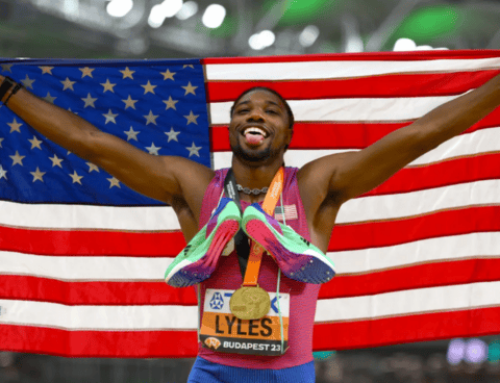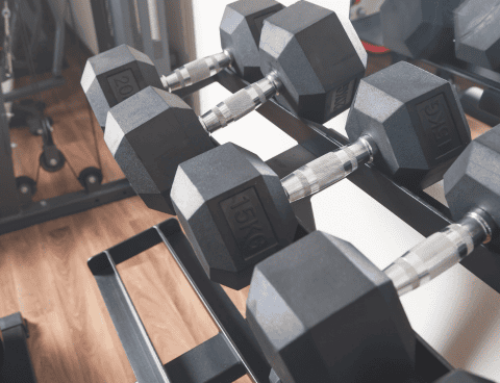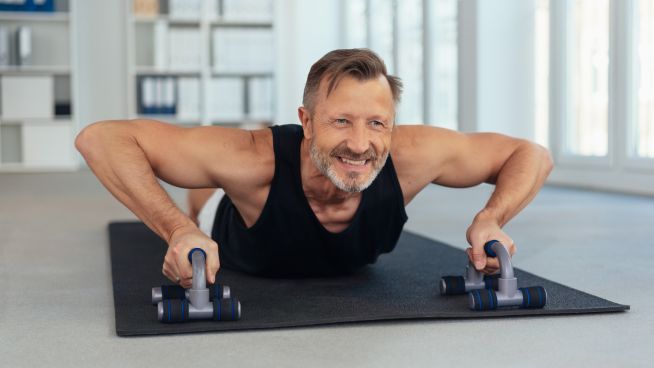Take the Triple Squat Challenge to Add Leg Strength and Size
![]()
The many benefits of Front, Back and Split Squats are well-documented. In addition, numerous variations of the “Squat Challenge” claim to be the toughest and most effective workout for strength and overall leg development.
With the Triple Squat Challenge, you can incorporate all three of the most effective squat variations into a single workout to maximize strength, size and endurance gains. It will add significant strength, mass and endurance to your legs, while enhancing overall athleticism in the process.
RELATED: Front Squat 101: A How-To Guide
The workout is by no means easy: The Triple Squat Challenge will push you both physically and mentally, yet also lead to significant gains in athleticism and sports performance.
Revisting the Squat

Squats, broadly defined, provide a superior training stimulus for all the muscle groups of the legs and core, including the quadriceps, hamstrings, gluteals and trunk. In addition, each of these variations is “ground-based,” implying that you can generate maximal force when performing them—especially when you employ the ‘bilateral’ or two-leg front and back squat variations. This leads to increased neuromuscular activation and motor unit recruitment of legs, enhancing force production and leading to overall better strength and power gains in the process.
RELATED: Improve Your Squat Depth With 5 Easy Warm-Up Exercises
As Tony Bonvechio illustrates in his article, the nature of muscle recruitment and motor activation separates and distinguishes the Front and Back Squats. Both have requisite mobility and stability standards athletes must meet to successfully (and safely) execute each variation, at depth, with proper form and technique. In addition, depending upon the loading parameters, tempos and sets and reps schemes, Front and Back Squats represent two of the most versatile lifts an athlete can adopt within a program. This can lead to targeted training adaptations that improve key athletic attributes, including maximal strength and power levels, muscle mass and strength-endurance levels.
Split Squats, on the other hand, are generally regarded as a unilateral variation of squatting. Depending upon whether you use a barbell or dumbbells, Split Squats may or may not involve axial loading/direct loading of the spine. Like their bilateral cousins, Split Squats require both hip and knee flexion and extension, targeting the same key leg and core musculature mentioned above. However, their single-leg/unilateral nature, combined with a much smaller overall base of support, challenge the body far more in the frontal plane. This forces muscles like the gluteus medius and quadratus lumborum to work harder to stabilize the hips and pelvis, so as not to collapse side-to-side or lose overall core positioning when performing them.
This is huge from a sports performance standpoint, given the fact that many on-field actions, including sprinting, cutting and accelerating, require significant degrees of single-leg strength, stability and power. In addition, the hip flexor of the trail leg (when performing Split Squats), is also subject to a much greater stretch than conventional Front or Back Squats, which studies show actually more closely mimics the leg stance of a typical high speed sprint model. To this end, the Split Squat can be seen as an exercise that develops solid ankle, knee and hip proprioception and stability, as well as an exercise that more closely mimics the mechanics of maximal sprinting.
RELATED: The Squat Variation That Torches Your Core
The Best of All Worlds

An athlete who performs the Triple Squat Challenge experiences the upper-back and quadriceps strength benefits of Front Squats; the posterior-chain development and maximal force-producing benefits of Back Squats; and the structural balance, proprioception, and hip mobility benefits of Split Squats. TSC is the classic triple-threat workout.
Workout
- A1. Barbell Front Squat: 5×5 (20X0 Tempo), rest 30 seconds
- A2. Barbell Back Squat (with same weight as Front Squat): 5×5-7 (20X0 Tempo), rest 30 seconds
- A3. Dumbbell Split Squats: 5×8-10 each side (30X0 Tempo), rest 3 to 4 minutes
Notes
- Five sets are prescribed, although starting with 3 sets and working up to 5 sets over the course of few weeks is recommended for new trainees.
- Rest periods should remain consistent: Less than 3 minutes after performing Split Squats is not recommended, as the weights are most likely too light/not intense enough to elicit gains in maximal strength or functional hypertrophy/muscle mass. Greater than four minutes rest between sets suggests weights may be too intense or neurally taxing, leading to overtraining.
- After 5 sets are achieved, the next progression is to go back to 3 sets but increase the overall weight on the Front and Back Squat. Even a small increase in weight can change the workout enough to elicit further gains and adaptations.
- By manipulating the workout and keeping reps lower (5, 5 & 8 reps for Front Squat, Back Squat and Split Squat) instead of higher (5, 7 & 10 reps), you achieve more of a strength/neural stimulus from the workout, as opposed to a metabolic/strength endurance stimulus in the latter example.
- The Front Squat weight (and subsequent Back Squat weight) should not be a true 5 RM/85% load! We recommend that athletes start with a weight that is more like a 6, 7, or 8 RM load. The cumulative stress and fatigue from this workout need to be taken into consideration, so the athlete does not “bomb out” after the first couple of sets.
How the Program Works

The Triple Squat Challenge workout is based on a variety of training principles, including the inclusion of “maximal voluntary muscle contractions,” which lead to enhanced motor-unit activation within the leg musculature. In addition, the beauty of this program is that because it is principles-based, the athlete performing the workout reaps the full benefits of a training session that accomplishes the following:
- TSC uses three Squat methods (Front, Back & Split), which are proven to enhance leg strength, size, mobility, structural balance and power/rate-of-force development.
- TSC adopts a loading scheme that abides by the law of repeated efforts, which employs a narrower rep-range pyramid, leading to enhanced strength and muscle size adaptations. Because the reps/lifting percentages for each of the 3 Squat variations fall within ~10-15% of one another, the session is prevented from confusing the body’s adaptive mechanisms, which is often encountered on a cellular level when exercises in a session have rep ranges that are too dissimilar—pulling the body in different directions and blunting overall strength and size gains. To understand the power of such training concepts, an athlete need only to look at the most successful collegiate strength programs in the U.S., where influences of Cal Dietz (2012) and his “Tri-phasic” training system are widespread. Coach Dietz keeps rep ranges small and specific in his workouts, and he actually programs specific muscle contraction types to maximize training adaptations, limiting cellular interference even more! This outlook on training has been backed by Soviet researchers for decades, making gains from TSC even more targeted and direct/effective!
- TSC works through the entire motor-unit pool of the legs. Basically, the loading scheme of the workout activates both fast-twitch and slow-twitch muscle fibers of the working leg muscles, increasing the size, thickness and force-coupling characteristics of the muscle fibers. Put simply, more muscle activation means more strength gains and muscle growth.
- TSC is a variation of the “Mechanical Advantage Extended Set” (MAES) outlined by Poliquin (2006) and used successfully by football and rugby strength coaches the world over, who are looking to maximize strength and size gains of their athletes during the off-season. What characterizes the session as an MAES is that the weight for the Front and Back Squat stays the same during the workout. The premise of this format is that an athlete’s maximal Front Squat weight should represent ~85% of his or her maximal Back Squat weight. Therefore, in following a typical predictive weightlifting percentage chart, where a 5-rep max is often seen to represent ~85% of a 1RM, an athlete who can front squat 315 pounds for 1 rep should theoretically be able to back squat that same weight for 5 reps (assuming the athlete is structurally balanced and the percentages are relevant). This is because as mentioned by Bonvechio in his article, the placement of the bar provides a different degree of “mechanical advantage to the lifter” by working and activating the muscles to different degrees, depending on whether the Front Squat or Back Squat is adopted. By starting with the squat variation that provides the least mechanical advantage (Front Squat) and finishing with the exercise that provides the greatest mechanical advantage (Dumbell Split Squat), the athlete is able to work through the full motor-unit pool of the fast- and slow-twitch muscle fibers of the legs, again enhancing maximal strength, size and strength-endurance levels in the process.
- TSC require minimal set-up, since all an athlete really needs is a squat rack, barbell and a pair of dumbbells. This saves time and maximizes efficiency in the weight room!
In summary, the Triple Squat Workout Challenge is a great way to develop maximal leg strength, size and endurance, while minimizing time and maximizing overall efficiency in the weight room. TSC is a great workout to perform during the early to mid off-season, for athletes like football and rugby players who are looking to make significant gains in leg strength and size. Due to the focused training stress of the workout, each of the three Squat variations complement one another, maximizing focused training adaptations. What TSC lacks in complexity, it more than makes up for in mental toughness and results.
References
- Bonvechio, Tony. “Front Squat vs. Back Squat: What’s the Better Choice for Athletes?” STACK. STACK Velocity Sports Performance, 25 Aug. 2014. Web. 09 Aug. 2016.
- Dietz, Cal, and Ben Peterson. Triphasic Training: A Systematic Approach to Elite Speed and Explosive Strength Performance. Hudson, WI: Bye Dietz Sport Enterprise, 2012. Print.
- Gentilcore, Tony. “The Pros and Cons of Percentage Training.” Strength Training, Bodybuilding & Online Supplement Store. T Nation, 4 Jan. 2016. Web. 09 Aug. 2016.
- Poliquin, Charles. Modern Trends in Strength Training: Successful Methods for Strength and Mass Development. Chicago, IL: Poliquin Performance Centers, 2006. Print.
- Wolf, Alex. “The Split Squat.” The Split Squat (2006): n. pag. UKSCA. Web. 8 Aug. 2016.
RECOMMENDED FOR YOU
MOST POPULAR
Take the Triple Squat Challenge to Add Leg Strength and Size
![]()
The many benefits of Front, Back and Split Squats are well-documented. In addition, numerous variations of the “Squat Challenge” claim to be the toughest and most effective workout for strength and overall leg development.
With the Triple Squat Challenge, you can incorporate all three of the most effective squat variations into a single workout to maximize strength, size and endurance gains. It will add significant strength, mass and endurance to your legs, while enhancing overall athleticism in the process.
RELATED: Front Squat 101: A How-To Guide
The workout is by no means easy: The Triple Squat Challenge will push you both physically and mentally, yet also lead to significant gains in athleticism and sports performance.
Revisting the Squat

Squats, broadly defined, provide a superior training stimulus for all the muscle groups of the legs and core, including the quadriceps, hamstrings, gluteals and trunk. In addition, each of these variations is “ground-based,” implying that you can generate maximal force when performing them—especially when you employ the ‘bilateral’ or two-leg front and back squat variations. This leads to increased neuromuscular activation and motor unit recruitment of legs, enhancing force production and leading to overall better strength and power gains in the process.
RELATED: Improve Your Squat Depth With 5 Easy Warm-Up Exercises
As Tony Bonvechio illustrates in his article, the nature of muscle recruitment and motor activation separates and distinguishes the Front and Back Squats. Both have requisite mobility and stability standards athletes must meet to successfully (and safely) execute each variation, at depth, with proper form and technique. In addition, depending upon the loading parameters, tempos and sets and reps schemes, Front and Back Squats represent two of the most versatile lifts an athlete can adopt within a program. This can lead to targeted training adaptations that improve key athletic attributes, including maximal strength and power levels, muscle mass and strength-endurance levels.
Split Squats, on the other hand, are generally regarded as a unilateral variation of squatting. Depending upon whether you use a barbell or dumbbells, Split Squats may or may not involve axial loading/direct loading of the spine. Like their bilateral cousins, Split Squats require both hip and knee flexion and extension, targeting the same key leg and core musculature mentioned above. However, their single-leg/unilateral nature, combined with a much smaller overall base of support, challenge the body far more in the frontal plane. This forces muscles like the gluteus medius and quadratus lumborum to work harder to stabilize the hips and pelvis, so as not to collapse side-to-side or lose overall core positioning when performing them.
This is huge from a sports performance standpoint, given the fact that many on-field actions, including sprinting, cutting and accelerating, require significant degrees of single-leg strength, stability and power. In addition, the hip flexor of the trail leg (when performing Split Squats), is also subject to a much greater stretch than conventional Front or Back Squats, which studies show actually more closely mimics the leg stance of a typical high speed sprint model. To this end, the Split Squat can be seen as an exercise that develops solid ankle, knee and hip proprioception and stability, as well as an exercise that more closely mimics the mechanics of maximal sprinting.
RELATED: The Squat Variation That Torches Your Core
The Best of All Worlds

An athlete who performs the Triple Squat Challenge experiences the upper-back and quadriceps strength benefits of Front Squats; the posterior-chain development and maximal force-producing benefits of Back Squats; and the structural balance, proprioception, and hip mobility benefits of Split Squats. TSC is the classic triple-threat workout.
Workout
- A1. Barbell Front Squat: 5×5 (20X0 Tempo), rest 30 seconds
- A2. Barbell Back Squat (with same weight as Front Squat): 5×5-7 (20X0 Tempo), rest 30 seconds
- A3. Dumbbell Split Squats: 5×8-10 each side (30X0 Tempo), rest 3 to 4 minutes
Notes
- Five sets are prescribed, although starting with 3 sets and working up to 5 sets over the course of few weeks is recommended for new trainees.
- Rest periods should remain consistent: Less than 3 minutes after performing Split Squats is not recommended, as the weights are most likely too light/not intense enough to elicit gains in maximal strength or functional hypertrophy/muscle mass. Greater than four minutes rest between sets suggests weights may be too intense or neurally taxing, leading to overtraining.
- After 5 sets are achieved, the next progression is to go back to 3 sets but increase the overall weight on the Front and Back Squat. Even a small increase in weight can change the workout enough to elicit further gains and adaptations.
- By manipulating the workout and keeping reps lower (5, 5 & 8 reps for Front Squat, Back Squat and Split Squat) instead of higher (5, 7 & 10 reps), you achieve more of a strength/neural stimulus from the workout, as opposed to a metabolic/strength endurance stimulus in the latter example.
- The Front Squat weight (and subsequent Back Squat weight) should not be a true 5 RM/85% load! We recommend that athletes start with a weight that is more like a 6, 7, or 8 RM load. The cumulative stress and fatigue from this workout need to be taken into consideration, so the athlete does not “bomb out” after the first couple of sets.
How the Program Works

The Triple Squat Challenge workout is based on a variety of training principles, including the inclusion of “maximal voluntary muscle contractions,” which lead to enhanced motor-unit activation within the leg musculature. In addition, the beauty of this program is that because it is principles-based, the athlete performing the workout reaps the full benefits of a training session that accomplishes the following:
- TSC uses three Squat methods (Front, Back & Split), which are proven to enhance leg strength, size, mobility, structural balance and power/rate-of-force development.
- TSC adopts a loading scheme that abides by the law of repeated efforts, which employs a narrower rep-range pyramid, leading to enhanced strength and muscle size adaptations. Because the reps/lifting percentages for each of the 3 Squat variations fall within ~10-15% of one another, the session is prevented from confusing the body’s adaptive mechanisms, which is often encountered on a cellular level when exercises in a session have rep ranges that are too dissimilar—pulling the body in different directions and blunting overall strength and size gains. To understand the power of such training concepts, an athlete need only to look at the most successful collegiate strength programs in the U.S., where influences of Cal Dietz (2012) and his “Tri-phasic” training system are widespread. Coach Dietz keeps rep ranges small and specific in his workouts, and he actually programs specific muscle contraction types to maximize training adaptations, limiting cellular interference even more! This outlook on training has been backed by Soviet researchers for decades, making gains from TSC even more targeted and direct/effective!
- TSC works through the entire motor-unit pool of the legs. Basically, the loading scheme of the workout activates both fast-twitch and slow-twitch muscle fibers of the working leg muscles, increasing the size, thickness and force-coupling characteristics of the muscle fibers. Put simply, more muscle activation means more strength gains and muscle growth.
- TSC is a variation of the “Mechanical Advantage Extended Set” (MAES) outlined by Poliquin (2006) and used successfully by football and rugby strength coaches the world over, who are looking to maximize strength and size gains of their athletes during the off-season. What characterizes the session as an MAES is that the weight for the Front and Back Squat stays the same during the workout. The premise of this format is that an athlete’s maximal Front Squat weight should represent ~85% of his or her maximal Back Squat weight. Therefore, in following a typical predictive weightlifting percentage chart, where a 5-rep max is often seen to represent ~85% of a 1RM, an athlete who can front squat 315 pounds for 1 rep should theoretically be able to back squat that same weight for 5 reps (assuming the athlete is structurally balanced and the percentages are relevant). This is because as mentioned by Bonvechio in his article, the placement of the bar provides a different degree of “mechanical advantage to the lifter” by working and activating the muscles to different degrees, depending on whether the Front Squat or Back Squat is adopted. By starting with the squat variation that provides the least mechanical advantage (Front Squat) and finishing with the exercise that provides the greatest mechanical advantage (Dumbell Split Squat), the athlete is able to work through the full motor-unit pool of the fast- and slow-twitch muscle fibers of the legs, again enhancing maximal strength, size and strength-endurance levels in the process.
- TSC require minimal set-up, since all an athlete really needs is a squat rack, barbell and a pair of dumbbells. This saves time and maximizes efficiency in the weight room!
In summary, the Triple Squat Workout Challenge is a great way to develop maximal leg strength, size and endurance, while minimizing time and maximizing overall efficiency in the weight room. TSC is a great workout to perform during the early to mid off-season, for athletes like football and rugby players who are looking to make significant gains in leg strength and size. Due to the focused training stress of the workout, each of the three Squat variations complement one another, maximizing focused training adaptations. What TSC lacks in complexity, it more than makes up for in mental toughness and results.
References
- Bonvechio, Tony. “Front Squat vs. Back Squat: What’s the Better Choice for Athletes?” STACK. STACK Velocity Sports Performance, 25 Aug. 2014. Web. 09 Aug. 2016.
- Dietz, Cal, and Ben Peterson. Triphasic Training: A Systematic Approach to Elite Speed and Explosive Strength Performance. Hudson, WI: Bye Dietz Sport Enterprise, 2012. Print.
- Gentilcore, Tony. “The Pros and Cons of Percentage Training.” Strength Training, Bodybuilding & Online Supplement Store. T Nation, 4 Jan. 2016. Web. 09 Aug. 2016.
- Poliquin, Charles. Modern Trends in Strength Training: Successful Methods for Strength and Mass Development. Chicago, IL: Poliquin Performance Centers, 2006. Print.
- Wolf, Alex. “The Split Squat.” The Split Squat (2006): n. pag. UKSCA. Web. 8 Aug. 2016.












